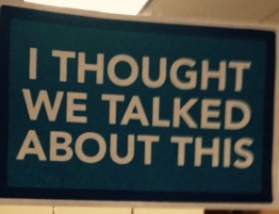
Personal Growth Through Networking
March 1, 2015
Finding Creative Solutions
March 3, 2015DEALING WITH POOR PERFORMANCE EMPLOYEES
No matter how much experience you have had as a manager, the most difficult part of the job is dealing with an employee’s poor performance. In fact, one of the most important ways that all organizations can improve their performance is to focus on improving the performance of the bottom 10% of employees. I have a belief that the bottom 10% determine the performance level of 50-60% of the employees that you manage.
People are not naïve – they know who is not engaged and who needs to improve or leave. In fact, in most organizations, people will judge their own performance by making sure that they perform just above the individuals at the bottom. It is actually worse than that – other employees will pay close attention to how you deal with these poorest performing individuals, and the way that you handle this group will have a significant impact on the culture of your organization going forward.
There are many reasons that some employees are not performing at the level you expect. There are outside issues such as health issues, family issues, and addiction issues, to name just a few. There are also organizational issues, such as poor training, lack of consistent management, lack of coaching, or a history of poor reviews that never addressed the problem. All in all, the effort to deal with poor performance, or to Not deal with poor performance, is a critical element of building a high performance work environment.
When dealing with the reasons for poor performance, lots of bad things can happen; these issues can easily be disruptive to a culture, they can foster divisive relationships inside the culture, and in the end leave you feeling like you are in the middle of a TV Soap Opera. The most difficult scenario involves dealing with employees that have Low Self-Esteem and have learned to use the victim mentality, which, most of the time, creates a passive-aggressive personality that can consume lots of valuable time and energy.
In dealing with the issue of improving a person’s poor performance, always be sure you are giving that person their Dignity through out the process. The worst outcome you can have is finding a way to remove the individual from the organization, but having all of the other employees watch someone lose their Dignity. Dignity is about someone’s self esteem and your fairness; you never want the people in your organization to judge your behavior as demeaning and unfair. In the longer run, their perception of you as a manager will be greatly impacted by your behaviors in handling these situations.
There is a big difference between for-profit, non-profit, and government agencies, in how you deal with poor performing employees. Non-profit and Government agencies have the most difficult cultural climates, and union contracts can make things even more complicated. I experienced a difficult example of that when I was the Executive Director of the University of Washington Alumni Association. This is a State of Washington job – and within the union contract more highly tenured workers can bump those lower in tenure working a similar classified job, if for some reason the higher tenured worker’s job is eliminated.
Well, this creates a unique set of challenges. At a public institution, one of the most important jobs is that of the receptionist. Alumni Associations also serve as one of the top first calls Alumni will make, to ask just about anything they want to know about the university – the only unit that takes more calls is Athletics.
I got the call from one of the campus units that they were closing down their receptions position to merge with another unit – that this was a union approved activity, and that the union employee had seniority over the receptionist we were currently employing. Translation: our young but very good receptionist, who was receiving unsolicited positive comments, was going to be laid-off and this more senior state employee would be taking her place. I found out later “Why” this happened. This person was a big problem and the other unit did not want to deal with this issue, so the only way they could get rid of the individual was to remove the job and give the issue they were unwilling to deal with to some other unit.
You know what happened: we started getting complaints immediately, the staff became upset because the original receptionist had made their jobs easier, and now everything was a problem to solve. The person was less than one year from retirement, had some very bad hygiene problems, was very rude to our callers and staff, and had a habit to arrive late and have to leave early on a regular basis, which meant others had to cover the desk. So what followed illustrates the complexity of the issue. I called the HR representative to discuss the problem, and in the discussion I asked why we simply could not offer a 6 month severance and health benefits to take the individual to their retirement age. Everybody would be happy.
Of course you know the answer: “we can’t do that”.
For the next 3-4 months, we entered the State’s Progressive Discipline process. First, the verbal warning was given and then 2-3 official write-ups, each one given by a program manager that had never been involved with this type of process. I attended weekly meetings with 5-8 people [my staff and HR people ]. The write-ups defined all of the issues: tardy attendance, bad attitude toward staff, phone complaints, etc. The process went through several twists: first, the individual got focused on being on time and staying later, and they were more polite to the staff [though follow through did not improve].
When we did the second write-up I became aware that while we were focused on some things that had improved, now we were creating what I almost could not believe: “A Hostile Work Environment”. We were hoping that our callers would complain – some staff members asked their contacts to call and give us feedback to use going forward in this process. After many weeks of Soap Opera discussions, lots of hours of wasted time discussing this process, I finally came back to my original request – to bridge this person to retirement – and now, after all of this effort, HR agreed and the individual was gone in one week.
The moral to this story has several truths.
- We treated the individual with dignity and respect, all aspects were handled in the spirit of Progressive Discipline process.
- The process took way more energy and time than it deserved and put both emotional and time-related burdens on many employees.
- Having gone through this process, it reinforces the idea: Hire the right people, because the cost of not having the right people is very high.
- As you read the rest of this post, understand that all of the basic management tools, if done correctly, will have incredible positive impact on how a workplace self-patrols and defines the expectations of a high performance culture.
Let me discuss some of my favorite ways to ensure that dealing with poor performance is effective and owned by the entire organization:
There are no easy answers to the problem of dealing with poor performance, but there is a simple solution, if you believe that you are managing for the long term and not just to get the next promotion. All of the suggested behaviors discussed below have an in-depth post on this blog site. With this article, I will try to keep to the concept level of discussion. If you are interested, a more detailed discussion is available in those articles.
In order to have a high performance, collaborative working environment you have to start with being able to define a clear and compelling vision that all employees share and are passionate about achieving. There are 3 possible types of management functions that your work group is responsible for; are you in operating mode, crisis mode, or are you in an initiative/change mode?
The first 2 modes focus on “What” you are producing and “How” you produce it. In crisis, the goal is to stop the crisis and get back to operating. The initiative mode requires more, people executing organizational change need to know and embrace “Why”.
In my article “The Architecture of Managing People”, I frame four basic truths about managing people –
1] People will do what they think they should do, how they think they should do it.
2] You need to know the values of the people you manage, why are they here – you can be successful and not like the success.
3] The most important thing a manager can do is make sure your team has the same picture of success as you do [see rule 1].
4] As a manager your primary function is to give your people resources and get out of their way.
The primary element of high performance cultures is a shared passion for a clear vision and shared values. With these two elements in place, the team will self-manage the poor performers out of the organization.
Once the vision is shared, the next step is to break down the vision, as much as possible, into specific behaviors that are owned by the employees. I have called this: “A Better Way to Operate”. This involves analyzing the most important employee interactions – clearly defining what has to go right every time, and aligning these behaviors into all of the traditional management tools: Job Descriptions, Training Efforts, Policy Alignment, Annual Reviews, Rewards Strategies – to name a few.
One of my favorite management practices was to annually sit down with each work group and my direct reports and have employees read their job description out loud. Once these had been read, I would ask 3 simple questions: 1] do you still do what the job description says you do? 2] are there new things you are doing that should be added to this document? and 3] What is in the way of doing your job?
As you can imagine, this practice was very important – as jobs change over time, especially when the organization is changing. More importantly, when the marketing group said that finance was making things difficult, and the finance team said marketing was not following the rules, I had a way forward – I got both teams together in a room, had them read both of their job descriptions out loud, and informed them that each group had answered the “In your way” question, citing the other group. I told them that I was leaving the room for 20 min, and when I came back I assumed they would inform me how this problem would be solved. I always held the job description meetings 6 months after last year’s reviews. I strongly recommend trying this out – It empowered the teams to solve their problems, not blame others.
A crucial part of this is creating a reward strategy that focuses on people doing things right. In today’s world having competitive employee contests will not work, we have all figured out that someone might win but the rest are all losers. Plus, the Millennials [under 35] don’t care about winning – they seek praise.
I had the privilege of watching a training session for the Seattle Police Department police dogs – I asked the officer: what is the most important method to achieve a high level of trust with the animals?
This answer I hope surprises you – the officer never punishes the dog. They never want the animal to hesitate, if the dog makes a mistake, they just take a step back and train up again. Think about how much time we spend telling our employees about their problems. I believe that what you focus on is what you will receive more of; if you are always picking one winner and spending time telling employees what they did poorly, then I believe you will just get more bad decisions: “What you reward is what you will get more of.”
Finally, a conversation about getting feedback from your users/clients/customers: As a manager, this involves receiving feedback from your employee, and taking control of the feedback from your superiors – take charge of how you get feedback and what you ask for feedback on. If you have followed my concepts, you’re familiar with the idea that getting feedback helps build the passion of your work group and your superiors.
Defining your own feedback strategy allows you to manage the expectations of everyone around you. The concept is very easy to do, once you have aligned your Vision, Job Descriptions, Reviews, Rewards Strategy, and Policies. You can frame the questions to match your management system. As example, the book “First Break All the Rules”, identifies 23 questions that the authors attribute to high performance cultures.
Here are two of them:
1] Do I know what is expected of me at work?
2] At work, do my opinions seem to count?
I spent 2 semesters teaching a masters level communications class at Seattle University. At the request of the students, I discussed the class goals – one of them being the survey I gave out at the end of the quarter on my performance. I promised that I would bring in real professionals working in many fields of interest, and that we would deal in theory, but that my goal was to also bring a practical element to the class, and so on. You can imagine how I was scored at the end of the class. Think about what I have covered in this article: Vision, Job Descriptions, Aligned Behaviors for high performance production, etc. Think about what you want your employees to say about your management by defining questions for feedback surveys that you want to score high on. You will be happy you did! What better way for people to become passionate about where they work and who they work for?
The closing thought: create a culture that empowers the employee, by defining clear expectations of how you will manage. Defining clear management behaviors is the best way to manage poor employee performance; let your employees manage the poor performance by caring about their culture. .





